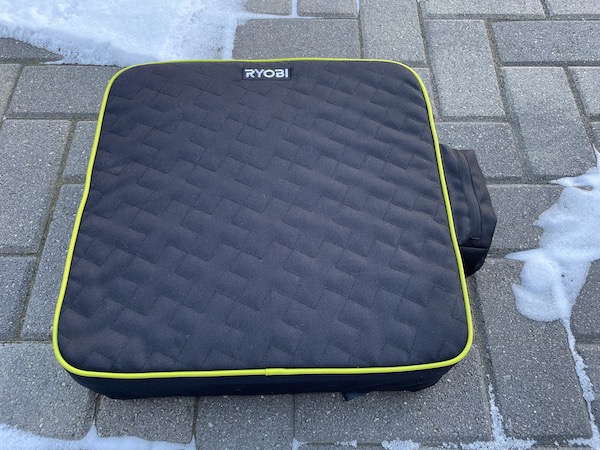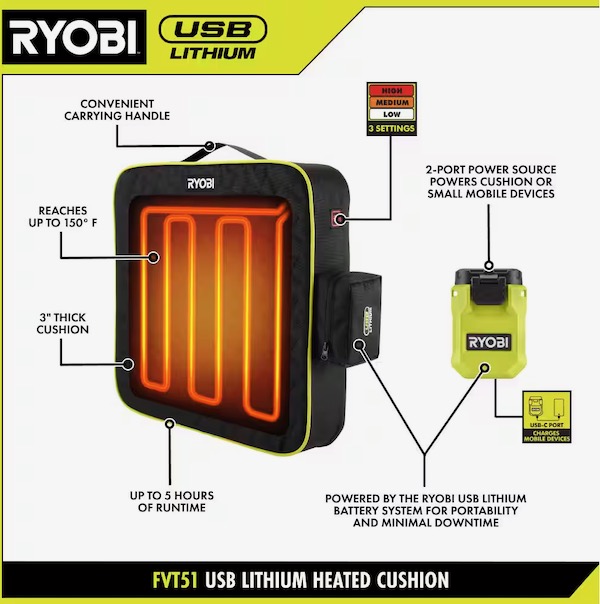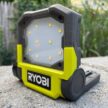Ryobi USB Lithium Heated Cushion
Ryobi USB Lithium Heated Cushion (FVT51K)
Here in the Northeast, we love to enjoy the great outdoors all year long. With the arrival of fall and winter, we turn to warm coats, gloves, and hats so that we can enjoy time outside with friends and family. Now that Ryobi has introduced their USB Lithium Heated Cushion, we are given the perfect device to bring comfort and warmth to the frigid environments that we enjoy spending time in.

Specifications:
- Integrated carrying handle
- Comfortable 3-inch thick cushion
- Runs for up to 5 hours (Using two (2) 2Ah batteries on low)
- 3 temperature settings: 150° F high, 130° F medium, 110° F low
- 2-port battery case heats cushion or charges mobile devices with USB-C port
- The 2 included USB Lithium 2Ah batteries feature a USB-C port that can also charge mobile devices
- LED fuel gauge on the battery indicates battery level status with the press of a button
- Includes: Heated Cushion, Power Case, two (2) USB Lithium 2Ah Batteries, one (1) USB Charging Cable
- 2-year battery manufacturer’s warranty
- 1-year cushion and power source manufacturer’s warranty
- Available at The Home Depot for $69.98

The Cushion’s Footprint
The Ryobi USB Lithium Heated Cushion arrives in an easily opened cardboard box. The cushion has a handsome black fabric cover with bright yellow piping around the top edge of the cushion. The top-side of the cushion is indicated by the patterned fabric cover, as well as the attached Ryobi label. The Heated Cushion itself is almost a perfect square at 14.75 inches from front-to-back and 14.75 inches from side-to-side.
The cushion’s cover is not washable, though you can spot clean it. Due to the electronics involved inside the cushion, the cushion should not be used in wet conditions, such as rain or snow.
The only thing I might have included is a “grippy” surface on the bottom of the cushion so that it remained in place when you altered your position on a smooth aluminum bench or plastic seat, for example.

So Comfortable!
The front-side of the cushion has a 12-inch zipper. The zipper pull itself is nicely hidden behind a recessed cover on the right side. I didn’t feel the opening itself was wide enough to comfortably remove the cushion and I didn’t want to risk trying.
Unzipping the zipper reveals the cushion, which is a very dense foam that is just over 3 inches thick. On day 1, the cushion was comfortable, though a bit firm. After frequent use for more than a month, the cushion has become softer, though it has still remained super supportive. Ryobi clearly used a high-quality material since the foam condenses when you sit atop it, but it later returns to its original form. After extended usage, I don’t worry about the cushion flattening and losing its support.

This cushion is so enjoyable to sit on, I found myself using it even without the heating element turned on. I frequently used the cushion on a kitchen chair or a stool and the difference was unbelievable. This cushion can make any hard and unforgiving chair so much more pleasant.
Lightweight And An Included Carrying Handle
The Heated Cushion is the perfect size for portability, but an added bonus is it’s also super lightweight. With the batteries installed, it is barely 2 pounds in weight. I am glad that Ryobi designed the Heated Cushion to weigh so little because that increases its utility.
Another design highlight is the built-in handle Ryobi included on the back side of the heated cushion. This fabric handle is securely stitched onto the cushion. The handle is 6-inches in size, which is more than big enough for most adults to grasp it firmly, even with gloves on. Carrying the cushion with us on road trips to our son’s Ultimate Frisbee tournaments was super easy because it weighed practically nothing and the handle allowed us easy grab-and-go convenience. For those that might take it camping, the handle would easily secure to your gear with a carabiner.

Battery Operation
The Ryobi USB Lithium Heated Cushion arrives with two (2) of their USB Lithium 2Ah batteries. Each battery needed to be charged upon opening the box. These batteries include the integrated fuel gauge button to indicate the remaining power based on the color of the LED indicator–a green light indicates it’s fully charged, an orange light indicates a half charge, and a red light means the battery is almost dead.
Ryobi also includes a USB-C port on each battery so that you can use them to charge your mobile devices with your own provided cord–I love this feature since they are so convenient to use as portable chargers. As is the norm for all of the Lithium 2Ah batteries that I have tested in the past, the batteries charge in approximately 100-110 minutes using the provided USB-C cord.

Battery Power Case
To hold the batteries, the Ryobi USB Lithium Heated Cushion comes with its own unique case, which is actually separate from the cushion. The power case is yellow and black plastic and it’s approximately 4-inches tall and 2.75-inches wide. At the top is a latching cover and inside the case are two receptacles for the batteries. The batteries need to be pushed down into the case, and once they are, they are very secure and won’t fall out by accident–I like how Ryobi secures all of their USB Lithium batteries inside their devices. The batteries must be removed from the power case in order to charge them.

At the bottom of the case is the USB-C output plug and a battery strength LED indicator that uses the same green and red LEDs to gauge battery life. This case can actually be used to charge a mobile device using a separate USB-C cable.
The power case is inserted into the pocket attached to the right side of the cushion. It makes sense that Ryobi designed the battery pack to be outside the cushion itself since it won’t impact the comfort level of the cushion when located there. The attached pocket has a large opening and a quality zipper to keep the battery pack from falling out of the pocket.
Ryobi also includes a permanently attached 5-inch USB-C cord inside this pocket, which is then attached to the base of the battery pack. I really liked how the cord was attached to the cushion since there was no fear of losing it and you don’t need to carry your own with you. The pocket is also very securely sewn onto the cushion’s exterior on all 4 sides.

Powering The Cushion
With the battery pack attached to the Heated Cushion, you are ready to power it on. The power button is also on the right side of the cushion, located directly next to the battery pocket. You need to press and hold the power button for 2 seconds to turn on the Heated Cushion.
The Ryobi engineers designed the cushion with three power settings so you could customize the amount of heat you needed, while also balancing how long you needed the batteries to last. After you turn it on, you press the power button consecutively to select from the 3 temperature settings, each indicated by its own light: high (red), medium (orange), and low (white). The color of the light on the button is very easy to recognize in both bright and dark conditions.

The Heat Is On High!
The first couple of times I formally tested the Heated Cushion, I did so atop our hardwood floors. For my testing, I borrowed the highly accurate Hilti PT-C Thermal Camera to take my temperature readings. Once the cushion was powered on, the Thermal Camera was easily able to identify the 3 heating coils inside the cushion, which were evenly positioned across the interior of the cushion.

I tested the Heated Cushion many different times at its highest setting. It heated up quickly, averaging a 25-degree increase in less than 5 minutes. I monitored the temperature every 5 minutes, and after 2 hours, the highest the temperature reached was 105° F, on average. All of this testing was done without me sitting atop the cushion.
Sitting on top of the cushion definitely helped to achieve greater temperatures. At the high power setting, the temperature averaged 106° F after 10 minutes. The heat remained steady between 104° F and 107° F each time I checked it. The top temperature I was able to reach was 116° F. After 2 hours, the temperature of the cushion could still reach 107° F, which attests to the longevity of the batteries. The efficiency of the heating elements inside the cushion definitely benefited from being compressed by my body weigh. My oldest son, a meteorologist, said this is a great example of the scientific principle of conduction. Ryobi claimed a high of 150° F at the high setting in their literature.

At the high setting, I could definitely feel the heat emanating from the cushion, even when wearing thick denim jeans. I felt that the heat was evenly spread across the entire cushion and the images using the Hilti PT-C Thermal Camera helped to prove that.
For comparison, when placed on high, the heated front seats inside my Honda SUV averaged 106° F-108° F. That temperature range was also consistently achieved by the Ryobi USB Lithium Heated Cushion.
Impressively, the 2 batteries did last for more than 2 hours and 20 minutes each time I tested them on the high power setting, which was longer than the 2 hours Ryobi stated online.
Medium Heat Setting
Operating the Heated Cushion at the medium setting increases the longevity of the batteries, while only slightly decreasing the temperature of the cushion. After multiple testings, the 2 batteries averaged more than 3 hours and 40 minutes of runtime at medium power, which is slightly more than the 3.5 hours Ryobi stated online. Sitting atop the cushion could produce temperatures of 102° F to 109° F on average. Ryobi claimed a high of 130° F at the medium setting in their literature.

Low Heat Setting
After multiple testings at the low setting, I found the 2 batteries averaged 5 hours and 15 minutes of runtime. This is in-line with Ryobi’s claim of 5 hours of power. Sitting atop the cushion could produce temperatures of 92° F to 99° F on average. Ryobi claimed a high of 110° F at the low setting in their literature.

Some Temperature Differences
I tested the Ryobi USB Lithium Heated Cushion on multiple occasions for more than a month. In addition to using the two batteries that came with the cushion, I also swapped them for other 2Ah Lithium batteries that I had. I also tested the cushion in a variety of indoor and outdoor settings.
While I enjoyed the pleasant heat produced by the Ryobi Heated Cushion, I was discouraged that the cushion never reached the temperatures Ryobi stated it could reach at each power setting. As I stated above, it was between 10° F and 30° F less than the high temperatures stated for each power level in the image below. I tried many things to achieve these high temperatures, but my Heated Cushion just couldn’t reach them. Despite these temperature differences, the Heated Cushion can still achieve some very warm temperatures that will make even the coldest hockey rink a lot more bearable.

A Heated Cushion Has A Wide Audience
The Ryobi Heated Cushion is exactly what you need when you choose to sit for long periods of time in cold locations. This cushion will come in handy this winter when the temperatures drop while sitting outside around a firepit. For the parents that attend football games under the Friday Night Lights in November, this cushion will make the aluminum bench much more comfortable. The “hockey moms” and “hockey dads” will really appreciate the Ryobi Heated Cushion at the early morning practices and late night games when the rink is close to freezing. I can imagine those that enjoy ice fishing would rather sit atop a soft, heated cushion than an uncomfortable, cold chair.
Of course a heated, soft cushion would also be appreciated by those that suffer from poor circulation, such as the elderly. Another use would be positioning it behind your lower back to ease sore and tired muscles.

Final Thoughts
After multiple testings in multiple locations, I found this Heated Cushion to be a game-changer when I was watching the “game” from an uncomfortable and cold seat. The cushion maintained a high level of comfort and support, up to 116 degrees of heat on high, and the batteries had great longevity–plus, since they are so small, you can conveniently bring more batteries with you when the game goes into overtime. If you are someone that loves to use the heated seats inside your car when winter arrives, I believe you will also enjoy the comfort of the Ryobi USB Lithium Heated Cushion.
Ryobi has recently released many different USB devices that use their 2Ah lithium batteries. These tools each can satisfy a unique need in your home, office, or workshop. I encourage you to have a look at some of these other handy devices here:
- Ryobi USB Lithium LED Compact Area Light
- Ryobi USB Lithium LED Compact Flashlight
- Ryobi USB Lithium LED Flip Light
- Ryobi USB Lithium LED Clamp Light
- Ryobi USB Lithium LED Magnifying Light
- Ryobi USB Lithium Power Scrubber
- Ryobi USB Lithium Clamp Fan
- Ryobi USB Lithium High Volume Inflator
- Ryobi USB Lithium VERSE Compact Speaker









